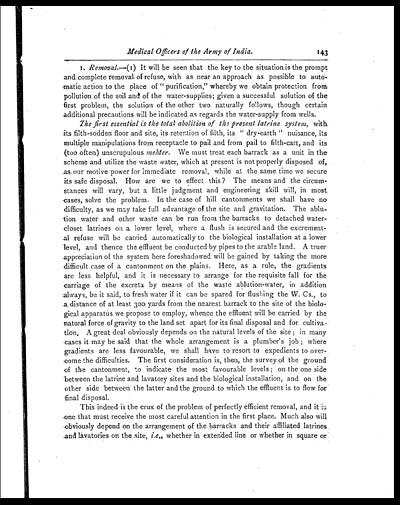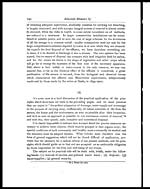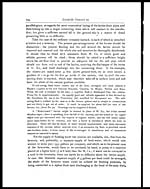Medicine - Institutions > Army health reports and medical documents > Scientific memoirs by medical officers of the Army of India > Part XII, 1901 > 6 - On some practical methods of sanitation in India with special reference to cantonments
(187) Page 143
Download files
Individual page:
Thumbnail gallery: Grid view | List view

Medical Officers of the Army of India.
143
1. Removal.— (1) It will be seen that the key to the situation is the prompt
and complete removal of refuse, with as near an approach as possible to auto-
matic action to the place of "purification," whereby we obtain protection from
pollution of the soil and of the water-supplies; given a successful solution of the
first problem, the solution of the other two naturally follows, though certain
additional precautions will be indicated as regards the water-supply from wells.
The first essential is the total abolition of the present latrine system, with
its filth-sodden floor and site, its retention of filth, its "dry-earth " nuisance, its
multiple manipulations from receptacle to pail and from pail to filth-cart, and its
(too often) unscrupulous mehter. We must treat each barrack as a unit in the
scheme and utilize the waste water, which at present is not properly disposed of,
as our motive power for immediate removal, while at the same time we secure
its safe disposal. How are we to effect this? The means and the circum-
stances will vary, but a little judgment and engineering skill will, in most
cases, solve the problem. In the case of hill cantonments we shall have no
difficulty, as we may take full advantage of the site and gravitation. The ablu-
tion water and other waste can be run from the barracks to detached water-
closet latrines on a lower level, where a flush is secured and the excrement-
al refuse will be carried automatically to the biological installation at a lower
level, and thence the effluent be conducted by pipes to the arable land. A truer
appreciation of the system here foreshadowed will be gained by taking the more
difficult case of a cantonment on the plains. Here, as a rule, the gradients
are less helpful, and it is necessary to arrange for the requisite fall for the
carriage of the excreta by means of the waste ablution-water, in addition
always, be it said, to fresh water if it can be spared for flushing the W. Cs., to
a distance of at least 300 yards from the nearest barrack to the site of the biolo-
gical apparatus we propose to employ, whence the effluent will be carried by the
natural force of gravity to the land set apart for its final disposal and for cultiva-
tion. A great deal obviously depends on the natural levels of the site; in many
cases it may be said that the whole arrangement is a plumber's job; where
gradients are less favourable, we shall have to resort to expedients to over-
come the difficulties. The first consideration is, then, the survey of the ground
of the cantonment, to indicate the most favourable levels; on the one side
between the latrine and lavatory sites and the biological installation, and on the
other side between the latter and the ground to which the effluent is to flow for
final disposal.
This indeed is the crux of the problem of perfectly efficient removal, and it is
one that must receive the most careful attention in the first place. Much also will
obviously depend on the arrangement of the barracks and their affiliated latrines
and lavatories on the site, i.e., whether in extended line or whether in square or
Set display mode to: Large image | Zoom image | Transcription
Images and transcriptions on this page, including medium image downloads, may be used under the Creative Commons Attribution 4.0 International Licence unless otherwise stated. ![]()
| Permanent URL | https://digital.nls.uk/75005304 |
|---|
| Shelfmark | IP/QB.10 |
|---|---|
| Additional NLS resources: | |




